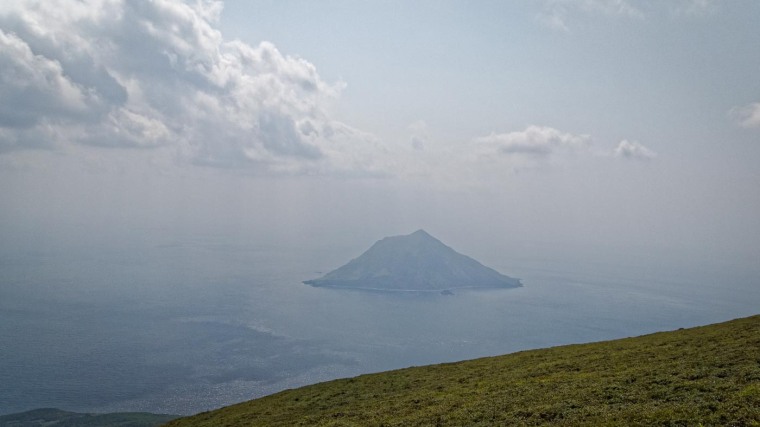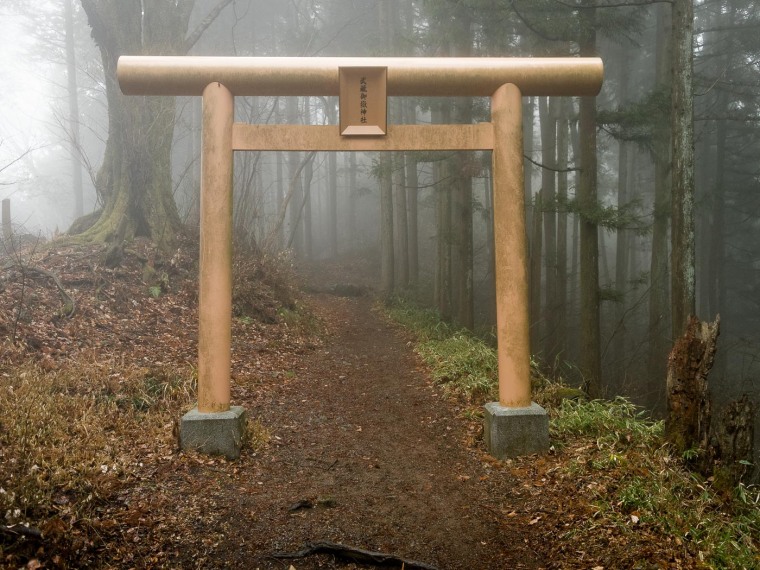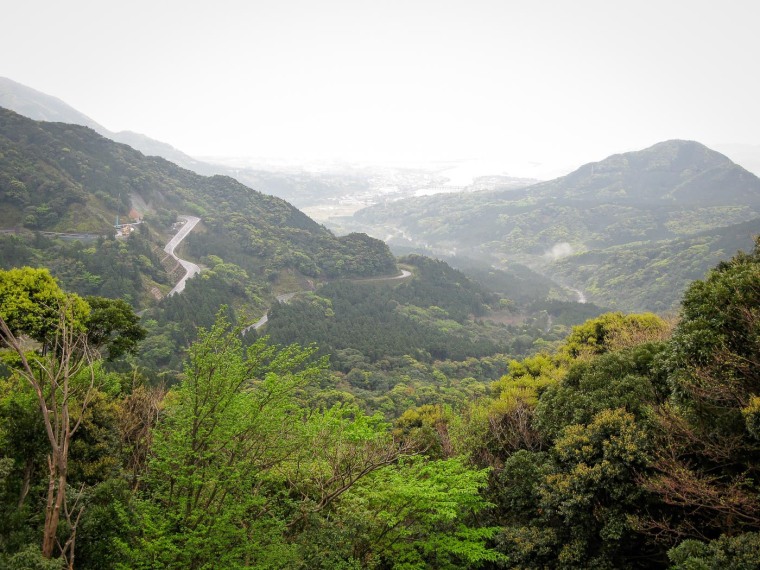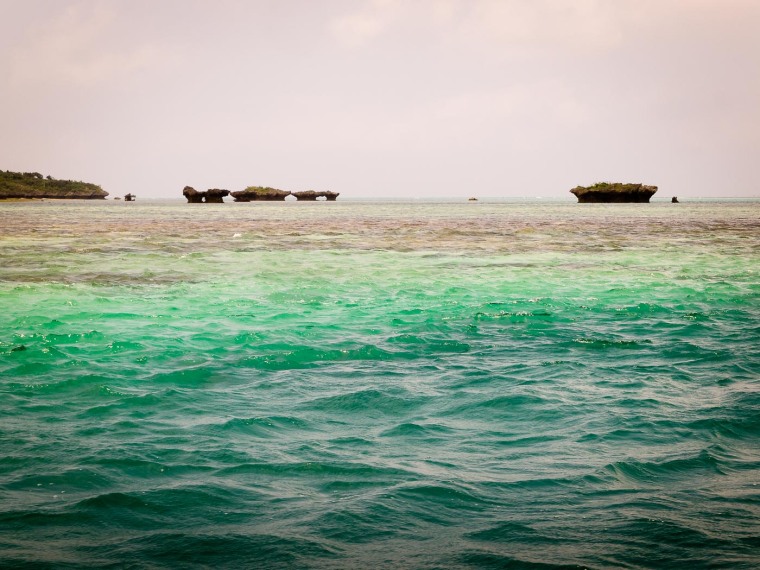花鳥風月, Kachou Fuugetsu: “experience the beauty of nature, learn about yourself.”
A tangle of scrub pine, roots bone-white in the gunmetal blue of a Hokkaido dusk. Around us low, forested mountains rolled out to sea. In one direction, the Russian Far East; in another, Tokyo and main-island Japan. Only 1500 meters (4500 feet) above sea level, but the harsh climate of Hokkaido — Japan’s northernmost, frontier island — put us already well above treeline. Below, I knew, higuma brown bears, cousin to the grizzly back home in Canada, foraged among the bamboo grass for bedtime snacks. We stood in the triangular shadow of the summit as night crept up-slope, looked over a lightless wilderness, and marvelled at the irony of two city kids from Canada travelling halfway around the world, to one of the most urban and densely populated parts of Asia, to wind up alone on a mountaintop in bear country.
Grizzlies weren’t high on the list of things my admittedly eclectic research on Japan had prepared me for: a sporadic diet of Lone Wolf and Cub, Black Rain, Kurosawa movies, Akira, and Godzilla, had prepared me more for the 85 million-person conurbation on main-island Honshu, the Tokyo-Osaka megalopolis. Nature, for all I knew, was limited to the disciplined gardens of bonsai trees and ikebana flower arrangements, rather than big-N Nature red in tooth and claw.
But in fact, as I was quickly learning, this high tech, near-future, post-industrial nation still has plenty of countryside and even wilderness. In fact, in many parts of the archipelago it seems more like the people are squeezed into what arable land exists, mainly on the coasts, while large parts of the island interiors remain uninhabitable, and thus undeveloped.
Of course, Hokkaido is not main-island Honshu. In fact, that’s kind of the point:
Japan is a surprisingly big and diverse place. 6,000 islands hang pendulously from wintry Russian Far East, all the way to distant Taiwan in the semi-tropical south. Honshu, Kyushu, and Shikoku and to an extent Hokkaido and Okinawa make up the bulk of what most visitors think of as “Japan,” but there are literally thousands of smaller islands which unfurl into the East China Sea.

Some islands are heavily developed, such as main-island Honshu with the Tokyo-Osaka conurbation (though, as you will learn, there’s still a lot of wildness left even on Honshu); others still have untouched forests of antediluvian fern and palm — such as on Iriomote — and millennia-old cedar — on Yakushima — at their mountainous hearts.

In fact, mountains — and volcanoes — are literally at the country’s heart, as Japan lies along the Pacific Ring of Fire – where 90% of the world’s earthquakes strike. In a not-unrelated fact, Japan also has 10% of the world’s active volcanoes. These mountains and volcanoes can really dominate the landscape, as is the case with some volcanic islands such as Rishiridake, at Hokkaido’s northern tip. Even on main-island Honshu, something like 70% of the terrain is mountainous – and thus undeveloped. These mountainous areas, such as the Daisetsuzan range in central Hokkaido, the Alps on Honshu, and the Kuju Renzan range on Kyushu, have been left undeveloped, and thus are essentially still wild places.

Once upon a time, when Japan was still basically an agrarian society, so much unfarmable mountain land must have been a hardship for the residents. Today, however, with Japan’s post- agricultural, post-industrial economy, these wild places are a popular refuge for trekkers, especially seniors, and an increasing number of fashionable young Mori (forest) and Yama (mountain) gals who wear designer boots and hats – and navigate by smartphone. Also recently, shinrin-yoku (森林浴): “forest bathing” trips have become popular as a way for stressed-out city dwellers to calm down by way of some natural hormone therapy.

In a country so profoundly affected by natural disasters including earthquakes, volcanoes, tsunamis and typhoons, maybe it’s not surprising that nature has long played a prominent role in Japanese culture. Even today, in this largely secular, high-tech, post-modern society, the traditional Shinto religion manifests in every village, town, and city, not to say forest and mountain. Despite the rather grand literal translation of the kanji characters 神道 as “way of the gods,” Shinto is in fact a rather local religion, and often appears rather modest in its daily appearance: mountains, trees, even rocks are sometimes acknowledged with rice straw rope and shide zigzag papers. It is for this reason that Fujisan is a sacred mountain. It is also for this reason that to this day yamabushi ascetic priests still train for endurance running and waterfall-standing in the mountains year-round, and why spirits such as tengu and kappa are still said to haunt the river valleys and cedar forests.
After nearly two decades of exploring Japan’s wild places, I have compiled a list of some of the locales which have made the biggest impression on me: and which I would recommend to anyone else adventuring in “the land of the rising sun:”
On Hokkaido, Japan’s northernmost island:
Teshiodake
A volcanic mountain with a distinct, dramatic pyramidal summit; one of the first places I laced up my trekking boots in Japan — and returned to again and again throughout my time on Hokkaido. The distinct, pyramidal summit may only be 1557.8 metres (4110 feet) in elevation, but this is Hokkaido: the treeless alpine zone starts as low as 1200 metres in these parts, an easy day climb to alpine vistas across the rolling Kitami mountain range.
Rishiri-to Island
An extinct volcano which rises out of the Sea of Okhotsk between Russia and Japan. On a clear day you can see both! We climbed from the free Rishiri-hokuroku campsite in June, and had the campground and trail nearly to ourselves. I returned in August, and was forced to squeeze my tent into a flat spot next to the congested trail.

Daisetsuzan National Park
“The Roof of Hokkaido” they call it, as there are 16 mountains with elevations above 2,000 meters (6562 feet), including Asahidake at 2,291 metres (7516 feet). Daisetsuzan is also famous for alpine meadow scenery and higuma brown bears. I did a two-night sawanobori river climb up the Kuwaaunni River on Mount Tomoraushi my first year in Japan, and lived to tell the tale.
Niseko
Off-piste snowboarder’s paradise. Apparently, Niseko has been named the “number two snowiest resort in the world,” with 15.11 metres (595 inches) of champagne powder falling annually. These days, Niseko is very much on the radar of the international ski set, and doubtless this has changed the fuinke, or atmosphere, of the place, but sanctioned off-piste skiing and snowboarding — a rarity in Japan — is still on the menu. This is probably the hottest, so to speak, ski resort in Japan these days.
On Main-island Honshu

Fujisan
On a clear day, Japan’s iconic mountain — actually a volcano — can be seen 95 kilometres (59 miles) away in Tokyo. Sacred Fujisan has what is called “prominence” in topographic-speak: it stands out from the contours of the surrounding terrain. In fact, Fuji’s near-symmetrical pyramidal slopes are so prominent they have become a national icon – and World Heritage site. Mount Fuji is easily climbed in summer and early autumn, although the popular routes from the fifth stations at about 2300 metres (7546 feet) to the summit at 3,776 metres (12388 feet) are also considered a grind. Popular wisdom has it that “only a fool climbs Fujisan more than once…” I climbed it once, under perfect conditions, and that was enough…

Chichibu/Okutama Mountains
Even within Tokyo, the Chichibu/Okutama mountain ranges provide an escape from the big city. Highlights include Takaosan, popular year-round, with — on a clear day — a view of Fujisan to the west. Pilgrims have worshipped at the summit-top shrine of Mitakesan, sacred with farmers, for millennia. For the record, R. and I exchanged marriage vows at Mitakesan’s shrine one storm-tossed day in May, and we still return at least once a year to check in with the local tengu forest guardians and renew our vows.

The Japan Alps
Yes, Japan also has Alps, a range – actually three — of mountains which bisect main-island Honshu. Next to Fujisan, which stands alone to the east, these are the some of the highest mountains in Japan, many of them over 3,000 metres (9843 feet) in elevation.

Kamikochi
Not surprisingly, there are many popular treks in the Alps. Kamikochi is a popular mountain resort in the North Alps, though the valley is closed off in winter to all but a guided tour group – I went in December of 2015…

Senjojiki Cirque
Apparently, some 20,000 years ago glaciers took a big scoop out of the flank of Mount Komagatake in the Central Alps, leaving behind a pond and flower-filled subalpine meadows in spring, and the red leaves of mountain ash trees in koyo autumn leaf season. A ropeway reaches Senjojiki Station at almost 2612 metres (8568 feet) — the highest ropeway station in Japan — and the Senjojiki Hotel, which can serve as a base for hiking to the Central Alps summits outside the cirque’s bowl.

Oze National Park
The largest highland marsh in Japan. About 150 kilometres (93 miles) north of Tokyo, Oze still seems to be on fewer “been there, done that” lists than many other trekking destinations relatively close to Tokyo. That said, it does apparently get quite busy in spring and summer, when skunk cabbage(!) and lilies, respectively, are in bloom. We went in October, when the marsh grass turned a particularly golden brown, and had the backcountry pretty much to ourselves.
Kyushu

Yakushima
They say it rains 35 days a month on this island just south of Kyushu. The ancient cedar rainforests, and waterfalls, make many peoples’ lists of power spots in Japan: it’s certainly hard to deny the pull of forests with trees which in some cases are reportedly up to 7,000 years old (which would make them, along with the bristlecone pine, the oldest living things on earth). But don’t just take my word for it: Kayao Miyazaki, co-founder of famed Ghibli studio, used Yakushima’s dense, mossy forest interior as inspiration for the setting of the anime Princess Mononoke.

Okinawa/Yaeyamas
Iriomote
1900 kilometres (1200 miles) from Tokyo, so far south it’s almost in Taiwan, Iriomote-jima is Japan’s Lost World wilderness, a tropical island of dense jungle, rivers, and mangrove swamps. Only a few thousand people live there, though hermits — refugees from the urban hothouses of Tokyo and Osaka far to the north — have been known to set up makeshift homesteads on remote beaches along the coast. Iriomote’s rainforest interior is one of the remotest, wildest places left in Japan: a day-long hike takes you through a Jurassic Park landscape of giant ferns and dense jungle canopy – not for the faint of heart! More accessible are the mangrove-lined Urauchi River, and the Pinaisara waterfall reached by tour boat.
Places still to try…
With 71% of the landmass mountains and over 6000 islands, this annotated list of places to explore only scratches the surface, as they say, of Japan’s wild side. Some of the places still left on my Honshu shortlist include the “snow monsters” of Mount Zao, Hakuba in autumn, and a return trip to Iriomote’s “lost world…”
I’ve spent nearly two decades exploring Japan’s wild places – and could easily spend another two discovering the rest – in fact, I plan to! In my travels, I have uncovered several places which have become personal power spots: places where I feel connected not just to nature here in Japan, but also to the wilds I left behind all those years ago in Canada. It’s not that Japan reminds me of Canada — the verdant green volcanic landscape is a world away from my home in dry, brown southern Ontario — but that being in nature anywhere in the world connects us to the earth in some basic, primordial way.
How about you? Do you have a power spot, or just a favourite place in wild Japan, you like to visit? Let us know in the comments section below!
Like the pictures you see here? I’m continually updating the Kachou Fuugetsu photo gallery with images from past and present trips.

Thanks for the great post. We would like to leave Canada in early May and ideally do a hut to hut trip somewhere remote in Japan. Around a week so we have enough time to do some hiking and explore. We would love to hear of any recommendations you may have. Appreciate it!
Hey LJ, early May is right at the beginning of the trekking season in many parts of Japan, and it can be a tricky time of the year to predict conditions. Last year, 2015, for example, we went to Kamikochi in the Japan Alps. Conditions were fine for hiking in the river valley – we had a great trip, actually, and I highly recommend the area – but were warned off the climb we’d intended as we hadn’t brought crampons for the snow. In fact, that time of year, many of the people in Kamikochi were still hauling backcountry skis and even snowboards into the surrounding mountains! So be prepared: if you want to get up into the mountains, you should be equipped and experienced for winter-like conditions. Encironment will be more temperate the further south you go: I expect areas around Kyushu – Aso-Kyushu National Park for example (see picsd at http://bit.ly/1QSuMmr) might be basically snow-free by then. Okinawa and the Yaeyamas, in the far south, of course, are basically snow free all year…
Another issue is the length of your trip. Are you looking for a week-long backcountry experience in Japan? That will be hard to find – Japan simply doesn’t have the space to walk into the wild for extended periods that you find in Canada. My usual trips involve hiking in to a hut to use as base camp for a couple of nights while day-hiking the suroounding area. Of course, mountainous areas such as the Alps and Daisetsuzan in Hokkaido have multiple areas with many huts that can be linked together into a longer trek, though a solid week seems a stretch. My Lonely Planet guide Hiking in Japan lists a five-day traverse of Daisetsuzan, but the listing includes provisos that this is a very demanding trail for very experienced hikers only and requires at least one night of tenting. Also, Daistesuzan, and Hokkaido in general, experiences severe winters with some of the heavisest snowfall in the world, literally, and early May may just be too soon for the trails to be passable. For me June was more the start of the mountain hiking season on Hokkaido – and even then I would still run into snowfields at elevation.
One last consideration: as you may already know there’s a national holiday “Golden Week” the end of April beginning of may, which may be the busiest time of year for people to travel. You may have issues finding accommodation and booking transportation if you haven’t made reservations already.
But don’t just take my word for all this! I would suggest going to a travel forum such as Lonely Planet’s Thorn Tree to ask if others have specific recommendations for the time of year you’re traveling. Also, if you can beg/borrow/steal a copy, Lonely Planet has the aforementioned best (only?) guide to hiking in Japan, approrpiatewly titled Hiking in Japan.
Have a great trip!
Here’s a thread on Lonely Planet’s Thorn Tree Japan forum discussing a week-long hike the Japan Alps from Murudo to Kamikochi. Definitely worth a look, LJ – and anyone else interested in long-distance hut-to-hut hiking on main-island Honshu. https://www.lonelyplanet.com/thorntree/forums/asia-north-east-asia/japan/long-japan-alps-hike-in-august-advice-needed
Thanks so much for the detailed reply and the link. I have been procrastinating on planning but with the departure date quickly approaching I am suddenly motivated. Posted a message on Thorn Tree and will see if I can download a pdf of Hiking in Japan. Appreciate your help!